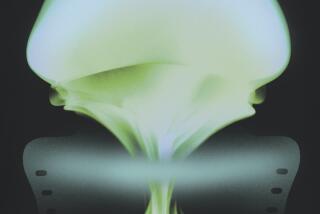Movie Review: ‘Hubble 3D’
The spectacular new Imax film “Hubble 3D” will be studied by astronomers, academics and Hollywood special effects artists for years to come. It’s a movie that not only puts you in space but lets you travel through it with a speed and wonder that would make James T. Kirk go a little weak in the knees.
The 43-minute documentary follows the crew of the space shuttle Atlantis on their May 2009 mission to repair and upgrade the Hubble Space Telescope. A 700-pound Imax 3-D camera accompanied them, anchored in the cargo bay, loaded with a mile of film. That translates into 8 1/2 minutes of footage to chronicle a 13-day mission. Needless to say, crew members were paranoid that they’d forget to switch the camera off and waste precious film.
Those scenes of the astronauts walking in space, performing delicate repair work while wearing what amounts to oven mitts on their hands, have a certain suspense. Narrator Leonardo DiCaprio works hard -- maybe a little too hard -- to muster up boyish wonder, though all the talk about tiny screws brings to mind “The Simpsons” episode where NASA shoots “blue-collar slob” Homer into space because the public has become bored with scientific minutia.
Director Toni Myers seems to recognize this, focusing the film’s energies on powerful images both familiar and new. Yes, we’ve seen shuttles blast into space before, but never with the clarity and snap-crackle-pop rumble that is captured here in both the close-up and distant shots of Atlantis’ launch.
Where “Hubble 3D” really separates itself from previous Imax space movies is in the photographs taken by the telescope itself, using its new wide field camera and infrared eye. These photographs, enhanced through computer-visualization techniques made by the Space Telescope Science Institute in Baltimore, allow viewers to blast through the farthest reaches of the universe with a real sense of discovery.
We pass by Sirius, beyond Orion’s belt and visit candy-colored “nests” of stars, each one a potential solar system. We fly through our own galaxy and witness the beautiful deaths of stars, their boiling caldrons of gases radiating into space, each one a blaze of glory.
Here, DiCaprio’s astonishment feels entirely appropriate. It’s impossible to view these solar systems and not feel a humbling appreciation for our own.
More to Read
Only good movies
Get the Indie Focus newsletter, Mark Olsen's weekly guide to the world of cinema.
You may occasionally receive promotional content from the Los Angeles Times.











